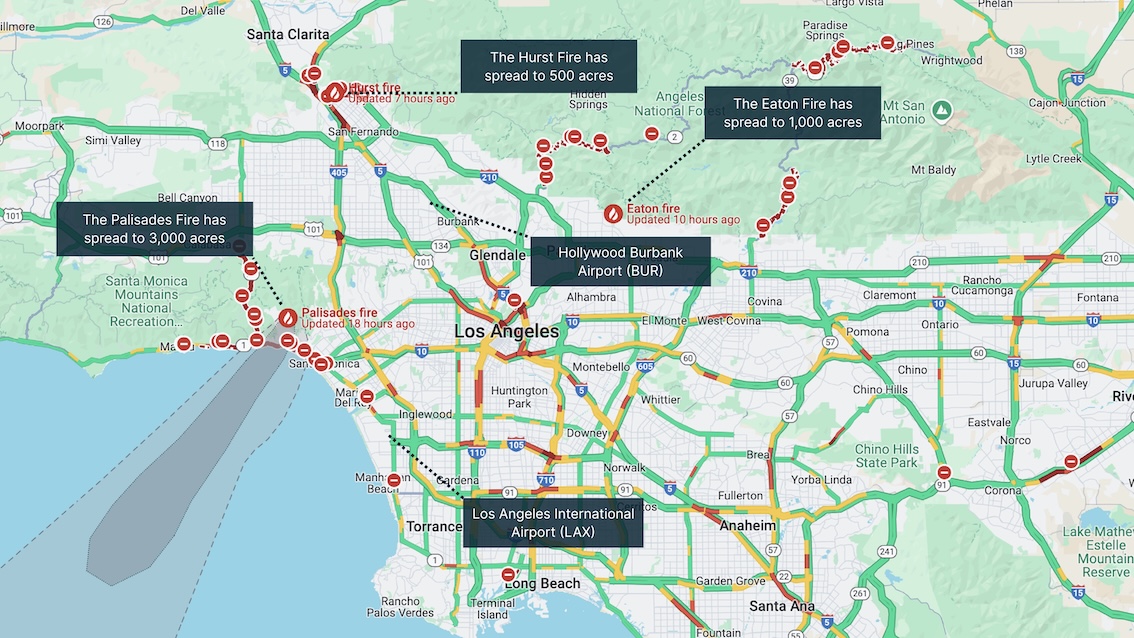Alert+
Evacuations from High-Risk Locations Call +44 (0)1202 308810 or Contact Us →
Power Outages and Evacuations Across LA Amidst Growing Wildfires
Intelligence cut off: 15:00 GMT 08 January 2025
Fast moving wildfires are currently ongoing in California. At least three separate blazes are currently ongoing around the Pacific Palisades (Palisades Fire), Pasadena (Eaton Fire), and Sylmar (Hurst Fire) neighborhoods of Los Angeles.
The Palisades Fire has burned through over 3,000 acres, causing significant damage, including the destruction of beachfront homes in Malibu; the Eaton Fire has spread to 1,000 acres; the Hurst Fire has grown to 500 acres. None of the wildfires have been contained as of the time of writing.
No deaths have been reported so far. Over 1,400 firefighting personnel have been deployed to combat the blazes and Governor Gavin Newsom declared a state of emergency.
Mandatory evacuation orders have been issued for over 80,000 people in Southern California. The Palisades Fire has triggered mandatory evacuation orders for the Pacific Palisades and surrounding areas. Residents in Malibu not currently under evacuation orders have been informed that they should prepare for evacuation anyway due to the how fast the wildfires are moving. A smoke advisory is in place around the Malibu Coast, Santa Monica, and Beverly Hills.
The Eaton Fire has prompted mandatory evacuation orders for the area north of Orange Grove/Rosemead Boulevard, east of Lake Avenue, and west of Michillinda Avenue. The Hurst Fire has triggered evacuation orders for northwest Sylmar and surrounding areas.
Major roads including Sunset Boulevard and part of the Pacific Coast Highway became gridlocked as residents fled the wildfires. Highway lanes near Topanga Canyon Boulevard closed due to the wildfire’s fast expansion. Drivers abandoned their cars on Sunset Boulevard, forcing The Los Angeles Fire Department to deploy bulldozers to Subset Boulevard to allow fire crews to pass abandoned vehicles.
The extreme conditions have resulted in widespread power outages, affecting more than 200,000 customers in Los Angeles County. Emergency shelters have been opened at Westwood Recreation Center and Ritchie Valens Recreation Center for evacuees from the Hurst and Palisades fires.

Map of the Palisades, Eaton, and Hurst fires to the north and west of Los Angeles.
SOLACE GLOBAL COMMENT
Evacuation and Response to 2025 LA Wildfires
The fires began on 7 January after a bush fire was caught by a windstorm, spreading the fire into surrounding areas. California is currently affected by the northeasterly Santa Ana winds, which are caused by high pressure over the Great Basin. These winds have fuelled many of California’s worst wildfires in the past, including the 2018 Woolsey fire, which killed three people.
The winds have reached speeds of approximately 100 km/h, and could reach 160 km/h in the mountains and foothills, areas which have not experienced substantial rain for months. Winds are expected to worsen on 8 January and continue into 9 January. They will highly likely continue to spread the wildfire, despite the fire department’s efforts.
Peak wildfire season in California typically occurs between July and October each year. Although wildfires are unusual in January, high winds have combined with particularly dry conditions in California to contribute to fertile conditions for the wildfire to spread. Rains of over 0.25 centimetres have not been experienced in Southern California since May 2024. The Santa Ana winds have exacerbated the dry conditions by reducing the humidity levels.
Fire hydrants have reportedly run out of water in the Palisades area. While water tanks are currently being used to supply water to fire fighters, this severely limits the extent to which the fire department can tackle the ongoing wildfires. The reason for the water shortage is currently unknown, but water shortages at fire hydrants may occur because of power outages, high demand during large fires, broken water mains, or drought conditions. Given the recent dry weather, the issues are likely influenced by low water supplies in Southern California.
The northeasterly winds are reportedly pushing smoke southwest towards Malibu. The South Coast Air Quality Management District (AQMD) predicts that PM2.5 levels will remain in the Unhealthy category in the Air Quality Index. Authorities have advised that residents utilise respirators when outside.
INTELLIGENCE ANALYSIS
Wildfire Spread in Southern California: High Winds and Infrastructure Strain
The fire department will highly likely continue to struggle to contain the fires. Increasing windspeeds and dry conditions already make it difficult to prevent the fast spread of the fire. This issue is exacerbated by the water shortages in the Palisades area, which is the location of the largest wildfire. Furthermore, the high windspeeds have meant that they have been unable to launch firefighting aircraft.
Given windspeeds are set to increase over the course of 8 January, wildfires are highly unlikely to die down over the next 24 hours. Despite the fire department utilising bulldozers to clear roads, the large quantities of abandoned vehicles will highly likely continue to hinder fire fighting operations.
Fire hydrants running out of water is not unprecedented. Recently, fire departments encountered low water pressure when tackling wildfires in Camarillo, California in November 2024, causing two water pumps to become inactive. While this slowed firefighting efforts, firefighters prioritised life-saving missions over protecting property and reportedly reduced the potential fatalities. Similar focus will almost certainly be employed in the Palisades area, where there is a water shortage.
In the aftermath of the wildfires, residents who have had their property destroyed are likely to ask questions regarding the lack of water in the fire hydrants. Much of California’s water infrastructure was built in the 1960s and 1970s, lacking advanced modern technology and prone to leaks and inefficiency. Given California has one of the highest water needs in the US, the government is likely to come under increasing pressure to modernise California’s water infrastructure in the months following the wildfire.
United Airlines has issued a travel waiver enabling itinerary changes for flights booked out of Hollywood Burbank Airport (BUR) and Los Angeles International Airport (LAX) between 7 and 9 January. Some flights into BUR, situated approximately in the middle of the three wildfires, have been diverted to LAX because of smoke from the fires. LAX has not yet had significant flight disruptions but is approximately 30 kilometres south of the Pacific Palisades.
The Palisades fire is currently burning in a westerly direction, according to the Los Angeles Fire Department. Therefore, there is a realistic possibility that LAX will avoid significant disruptions. However, if there is a shift in winds causing the Palisades fire to spread further south, then it will likely result in significant airport disruptions. While significant shifts in Santa Ana winds are unlikely, changes in the pressure systems could influence the wind direction.
Travel Risk Advice: Precautions for LA Wildfire Zones
- Adhere to all evacuation warnings issued by authorities promptly.
- Do not attempt to extinguish fires on your own; leave firefighting to professionals.
- Pack a grab-and-go bag containing essential items such as water, a flashlight, a portable charger, important documents, non-perishable food, and first aid supplies.
- Stay informed by monitoring local news and official updates regarding the wildfire’s spread.
- Familiarise yourself with the locations of government-designated evacuation shelters.
- Wear protective clothing, including long-sleeved shirts, long trousers, gloves, and an N95 mask, to safeguard against smoke and heat exposure.
- Avoid using water unnecessarily if firefighters are operating in your area, as resources may be limited.
- Plan multiple escape routes in advance, considering possible congestion or blockages caused by fires.
- If driving, keep windows closed and set your vehicle’s air conditioning to recirculate to minimise smoke exposure.
- Drive cautiously and at reduced speeds in areas with poor visibility due to smoke.
- If you plan to fly, confirm flight status with your airline to avoid complications from cancellations.
- Do not return to your home until authorities officially declare it safe to do so.
- Be aware that smoke may persist in the air even after the wildfire is extinguished. Continue wearing an N95 mask when returning to affected areas.

